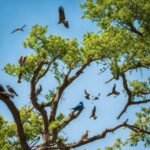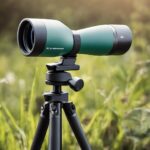Bird watching is a valuable contribution to scientific research. Participating in bird counts and other research projects, you can become a citizen scientist and help gather important data on bird populations and behaviour.
Understanding Citizen Science
Citizen science is a research methodology that engages ordinary people in scientific endeavours. It allows individuals to contribute to scientific studies and better understand the natural world. Citizen science can cover many topics, from monitoring biodiversity to tracking weather patterns.
Citizen science has a significant advantage in enabling researchers to gather data from a much wider area than would have otherwise been feasible. With the participation of many individuals, researchers can obtain data from various locations, providing a more extensive and comprehensive understanding of the subject under investigation.
Bird watching can provide valuable data on bird migration patterns, helping scientists understand how climate change affects the bird population and how the birds can be helped to mitigate the impacts.
In addition, bird watching can help to monitor nesting success and breeding season for different bird species and identify areas where conservation efforts are needed to protect breeding habitats and ensure the survival of these crucial species.
There are various citizen science projects with specific goals and objectives. For example, some projects monitor bird populations, while others track weather patterns. Water is also an essential area of study for bird watchers interested in citizen science projects. Monitoring water sources, such as ponds and wetlands, can help scientists understand how birds use these habitats and how they are affected by environmental changes.
Citizen science is a growing movement that allows ordinary people to contribute to scientific research, and bird watching is one of the most popular ways to get involved. One way to get involved in citizen science bird watching is to participate in bird counts. Local birding groups or conservation organizations organize these events and include counting the number of birds seen in a specific location during a set period.
One way to participate in bird research is by utilizing birding apps and websites to document and exchange your sightings with a community of fellow bird enthusiasts and researchers. Some apps even use artificial intelligence to identify bird species based on your photos or recordings, making it easier to contribute accurate data to ongoing research projects. Bring along your binoculars or spotting scope to get accurate data.
Bird Watching And Citizen Science Projects
If you’re interested in birds, participating in bird watching as a form of citizen science is simple and accessible. All you need are a pair of binoculars, a field guide, and a willingness to observe and record what you see. Installing a nest box is another way to get involved in citizen science projects. Nest boxes offer birds a safe and secure place to build their nests and raise their young. Installing one can increase your area’s bird population and provide valuable scientific research data.
By getting involved in bird counts and other research projects, you can contribute meaningfully to our understanding of the natural world, help protect the birds we love and a great way to appreciate nature and connect with the world around you. There are many opportunities to get involved in citizen science and contribute to a better understanding of these fascinating creatures.
Technology, Bird Watching And Citizen Science
Technology has revolutionized the way bird watchers participate in citizen science projects. With the advent of smartphones and apps, bird watchers can now easily record and share their observations with others.
If you are interested in contributing to bird conservation efforts while enjoying the outdoors, participating in bird counts and research projects is a great way to get involved. By participating in these and other bird counts and research projects, you can contribute to our understanding of bird populations and movements and help guide conservation efforts. The following are some of the ways technology has changed the game for bird watchers:
eBird
eBird is managed by the Cornell Lab of Ornithology and the National Audubon Society and is a database of bird sightings. If you’re an avid birdwatcher, you’ll love being able to submit your observations from anywhere around the world. Scientists use the data collected to understand bird populations and movements better. With eBird, you can easily enter your sightings, view bird distribution maps, and track your birding stats. You can also explore the website to find hotspots, track your progress and learn more about the birds in your area.
Merlin Bird ID App
The Merlin Bird ID app is a powerful tool for bird watchers, especially those new to the hobby. The app uses artificial intelligence to identify bird species based on photos or descriptions of the bird’s behaviour, habitat, and location. With Merlin, you can quickly and accurately identify birds in the field, making your bird watching experience more enjoyable and informative.
GBBC
Every February, the Great Backyard Bird Count (GBBC) motivates individuals to tally the number of birds they spot in their backyard or nearby park and report their findings to eBird. The information gathered from GBBC assists researchers in monitoring fluctuations in bird populations and contributes essential insights for conservation initiatives.
Project FeederWatch
Project FeederWatch is a bird counting project that occurs throughout the winter and focuses on birds visiting North America feeders. Participants must count the birds they see at their feeders and submit their data to the Cornell Lab of Ornithology. The collected data is used to track changes in bird populations and determine the species that may be at risk of decline.
NestWatch
NestWatch is a project that focuses on monitoring bird nests across North America. Participants can monitor nests in their backyard or nearby parks and natural areas. The data collected is used to track breeding success and to identify threats to nesting birds.
Christmas Bird Count
One of the most well known bird watching projects is the Christmas Bird Count, which has been taking place since 1900 in Canada. This annual event involves counting all birds spotted in a day by bird watchers across North America between December 14 and January 5. The Christmas Bird Count is the oldest citizen science project in the world, with over 100 years of data collection.
Participants count birds in a designated area on a specific day in December and submit their data to the National Audubon Society. The data collected tracks changes in bird populations over time and identifies species that may be in decline.
Smartphones
Documenting and sharing bird sightings is easier than ever with smartphones. You can take photos and videos, record songs and calls, and share observations in real time. You can also use your smartphone to access birding apps and online resources, enhancing your knowledge and understanding of the birds you encounter.
Photos
Photos are a valuable tool for bird watchers, allowing them to document and share their sightings with others. With high quality photos, researchers can identify species, track migration patterns, monitor changes in bird populations over time, create educational materials and raise awareness about the importance of bird conservation.
Citizen Science, Bird Observations And Data Collection
As a citizen scientist, your bird observations and data collection are crucial, so whether you are a beginner or an experienced bird watcher, every observation you make can contribute to scientific research and conservation efforts.
An excellent method for documenting your bird observations is by utilizing online platforms that enable you to input information on the species you have spotted, their location, and their behaviour. Additionally, you can attach audio recordings and photos to your observations, which is beneficial for researchers to identify bird species and analyze their behaviour.
When you submit your bird observations to eBird, adhering to the platform’s guidelines and protocols is important. These include giving precise location details, using the correct names for the bird species, and describing their behaviour accurately. To observe the birds, it is recommended to use binoculars or a spotting scope and take note of their actions and vocalizations.
In addition to eBird, you can keep a personal “life list” of the birds you’ve seen. A life list is a fun and rewarding way to track your bird watching progress while providing valuable data for researchers.
When gathering data, be consistent and systematic in your observations.
By participating in bird counts and other research projects, you can contribute to our understanding of bird populations and their conservation needs.
Final Thoughts
Participating in bird watching is an excellent opportunity to take part in citizen science projects and assist in scientific research. You can contribute by joining bird counts, setting up nest boxes, monitoring water sources and raptors, and reporting your bird sightings to help gain a better understanding of birds and their natural habitats.
Frequently Asked Questions
How do I participate in bird counts and other research projects?
To participate in bird counts and other research projects, you will need to find a project that interests you and follow the instructions for submitting your observations. Many projects have websites where you can create an account, enter your data, and track your contributions over time.
What are some benefits of participating in birdwatching citizen science projects?
Participating in birdwatching citizen science projects allows you to contribute to necessary scientific research, learn more about birds and their behaviour, and connect with other bird watchers. It can also be a rewarding leisure activity that allows you to give back to the community.
Can anyone participate in birdwatching citizen science projects, or do I need special training?
Most birdwatching citizen science projects are open to anyone, regardless of their experience or training. However, some projects may require you to complete a training program or pass a test before you can participate, so check the website or contact the project coordinator for more information.






